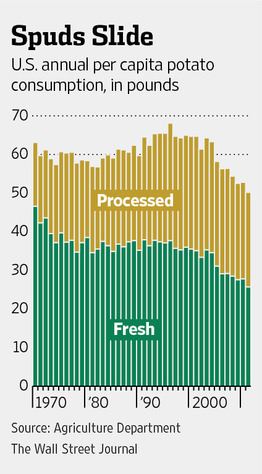The potato has had a great run for most of the past five centuries. But these days, the humble spud has fallen on hard times.
A darling of American dinner tables since before the nation's founding, potatoes have lost favor in the U.S. for the past two decades. Consumers have shunned the starchy side dish in a race away from carbohydrates and toward greater convenience, two factors driving broad changes in how Americans eat.
Total annual consumption of all types of potatoes has fallen by nearly 25 percent since peaking in 1996, to 52 pounds a person in 2012, the last year for which the U.S. Department of Agriculture has data. Consumption of fresh potatoes—the kind that are baked, chopped, mashed or hashed—has been dropping even further, to about 27 pounds in 2012, down more than 40 percent from about 47 pounds in 1970.
Time-pressed Americans, who are cooking less and less, can hardly spare the roughly 10 minutes it takes to microwave a whole potato, let alone the hour needed to bake them in conventional ovens.
Diana Dahl, a 47-year-old consultant, said she grew up eating potatoes in all forms, but now avoids making classic potato dishes to save time. “I prefer to have them made for me,”Dahl said.
While she also eschews french fries, she does allow herself potato chips as an indulgence, she said, as she picked out rice chips and quinoa cheddar chips in a Plum Market grocery in Chicago.

Health concerns started eating into potato sales in the late 1990s and early 2000s. The backlash against carbohydrates early last decade, with the rise of the South Beach and Atkins diets that heavily limit starches, darkened the tater's reputation.
Potatoes are still big business. The raw potato crop was valued around $4 billion in 2012, according to the USDA, but processed products are worth much more. Sales of potato chips and crisps totaled $7.5 billion last year, estimates research firm Euromonitor.
Companies are trying new products, promotions and flavors to reheat potatoes’ popularity, such as healthier versions of french fries and gourmet options like the petite fingerling variety.
"We're gonna bring the sexy back," said Chris Wada, marketing director for Wada Farms Marketing Group LLC, an Idaho-based grower, shipper and marketer of potatoes founded by Wada's grandparents in 1943.
Wada is about to launch a line of Smalls Artisan Mini-Potatoes, bite-size red or gold spuds specially packaged to cook in a microwave in five minutes.
The U.S. Potato Board, a Denver-based industry group, is running advertisements in lifestyle magazines to polish the potato's image as a health food. Past ads carried luscious photos of potato dishes with captions like, "just because it looks sinful doesn't mean it is." New ads direct readers to the Potato Board's website, which features potato-based recipes (some being "guilt-free"), nutritional facts and other resources.
A medium plain fresh russet potato has about 168 calories, 37 grams of carbohydrates, virtually no sodium or fat, and plenty of potassium and vitamin C, according to the USDA.
Prices for fresh potatoes are highly volatile, and have fallen especially sharply this summer for reasons that aren't clear. Russet Burbank potatoes in Idaho that were fetching as much as $8 per cwt. at the end of May were selling at between $3.25 and $4 by early August, according to Paul Patterson, an economist at the University of Idaho's Idaho Falls Research and Extension Center.
Bryon Reed, partial owner and grower at DB Reed Farms in Idaho, said the recent plunge is the sharpest he has seen in 40 years of farming, causing him about $250,000 in losses in one three-week period.
Still, he says overall he is seeing healthier demand in recent years, thanks partly to fingerlings and red potatoes. He says fingerlings cost about seven times more to grow than the standard Russet-Burbank variety, but sell for an even higher premium. "They're not healthier," he said. "They're just more unique."
It wasn't always so tough for taters. The Incas cultivated potatoes for millennia. Spanish conquistadors began the spread of the tuber's popularity in the 16th century when they brought them to Europe. Then European emigrants took them back across the Atlantic, planting in 1719 the first potato patches in what is now New Hampshire.
The spud gained a new friend in 1949, when a year-old outfit called McDonald's started selling fries with its burgers, spawning imitators across the fast-food industry. Forty-four years later, McDonald's Corp. started selling its signature side order in 7.1-ounce supersize portions, with 610 calories. McDonald dropped supersizes in 2004.
Some potato companies innovated to keep sales growing. In the early 2000s, PepsiCo, Inc.'s Frito-Lay division started experimenting with new flavors for its Lays potato chips to add to mainstays flavors like classic, barbecue, and sour cream and onion. Frito-Lays' chip sales have grown, and it remains by far the biggest player, with a nearly 70 percent share of the U.S. market last year, according to Euromonitor.
Much of the recent innovation around potatoes has been focused on calorie counts.
Burger King Worldwide, Inc. last year started selling Satisfries, advertised as having 40 percent less fat and 30 percent fewer calories than regular fries.
ConAgra Foods, Inc.'s Alexia brand of all-natural frozen foods has launched a line called Smart Classics featuring fries and frozen roasted potatoes with sea salt that are 98 percent fat free, 100 calories per serving and have no trans fat.
Source: The Wall Street Journal